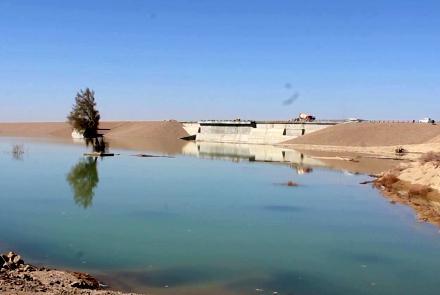Farmers and residents in the southwestern province of Nimruz have called on the central government to address the lack of water--for household use or to irrigate crops--and say that despite their hopes Kamal Khan Dam has not solved their problems.
They said the lack of water in the country, as well as the rising temperature, has made life difficult in the province.
Residents of Zaranj, the capital of Nimroz province, need to buy water from tanker trucks at high prices, as the well water in the city is not safe for drinking.
The residents of Nimroz had hopes that the Kamal Khan Dam would solve their problems, but it has not. In addition to the lack of safe drinking water, they do not have water for irrigation.
“There is no drinking water at all. We have to pay 700 to 800 Afghanis to get water from a 1,000-liter tanker,” said Rahmatullah Rahmani, a resident of Nimroz.
Tanker owners provide water from deep wells that are far from Zarang city.
“We do not have water in our house at the moment. We are looking for tankers everywhere. The tankers prefer to sell water to those who pay higher,” said Nimroz resident Mohammad Yousef Barakzai.
“People are facing water shortages and drought this year with the high temperatures of more than 50 degrees,” said Baz Mohammad Naser, chairman of the Nimroz Provincial Council.
Farmers in Nimroz say their agricultural fields and crops have been destroyed due to lack of water this year, and the Kamal Khan Dam has not helped them to tackle the water shortage problem as they expected.
They added that the Kamal Khan Dam’s water did not reach their fields.
“Since the day the dam was opened, the water has been lost in Nimruz,” Abdul Jamil Rukhshani, a farmer in Nimruz said.
“In Nimroz province, no one has had a good growing season, no one has a good Faliz (an area for growing melons). All is gone,” said Mohammad Sarwar, a farmer.
The construction of the Kamal Khan Dam began in the solar year 1345, but due to the war it was delayed. After five decades of waiting, the dam was eventually inaugurated by President Ashraf Ghani on March 24.
Kamal Khan Dam, which cost $111 million, was built on the Helmand River in the Chahar Burjak district of Nimroz province. It has the capacity to store 52 million cubic meters of water, irrigating more than 170,000 hectares of land, and generating 9 megawatts of electricity.
Meanwhile, the national water affairs regulation authority says that construction is underway to build six canals at Kamal Khan Dam to supply water to the people of Zaranj city and to agricultural areas.
“The construction of the Kamal Khan Dam is 100 percent complete. At the moment, work on the canals from the dam are underway, which are 65 percent complete,” said Nizamuddin Khpulwak, a spokesman for the national water affairs regulation authority.


Comment this post